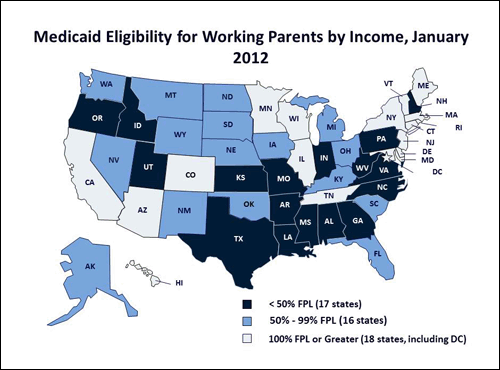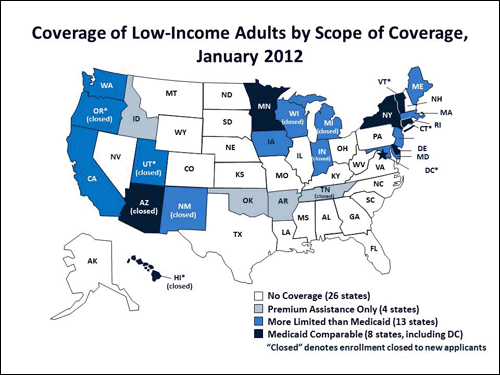States Getting a Jump Start on Health Reform’s Medicaid Expansion
One of the primary goals of the Affordable Care Act (ACA) is to decrease the number of uninsured through a Medicaid expansion to nearly all individuals with incomes up to 133 percent of the federal poverty level (FPL) ($14,856 for an individual or $25,390 for a family of three in 2012) and the creation of new health insurance exchanges. These coverage expansions, which will take effect in 2014, will eventually cover about 32 million uninsured people. The ACA also provided states flexibility to get an early start on the Medicaid expansion. As of March 2012, six states have moved early to expand Medicaid to adults to help prepare for and transition to 2014.
Survey data show that, to date, states have achieved significant success expanding Medicaid and CHIP coverage for children, but poor parents and other adults in many states remain ineligible for Medicaid (Figures 1 and 2). This reflects the fact that federal minimum Medicaid eligibility levels for parents are very low, and, prior to the ACA, states could not receive federal Medicaid matching funds to cover non-disabled adults without dependent children, regardless of their income.
Figure 1

NOTE: The federal poverty line (FPL) for a family of three in 2012 is $19,090 per year. Several states also offer coverage with a benefit package that is more limited than Medicaid to parents at higher income levels through waiver or state-funded coverage.
SOURCE: Based on the results of a national survey conducted by the Kaiser Commission on Medicaid and the Uninsured and the Georgetown University Center for Children and Families, 2012.
Figure 2

NOTE: Map identifies the broadest scope of coverage in the state. CT, DC, HI, & VT also offer coverage “more limited than Medicaid.” OR and UT also offer “premium assistance” with open enrollment.
SOURCE: Based on the results of a national survey conducted by the Kaiser Commission on Medicaid and the Uninsured and the Georgetown University Center for Children and Families, 2012.
Because of their historic exclusion from Medicaid, states could only cover low-income adults by receiving a Section 1115 waiver of federal Medicaid rules or through a solely state-funded program. Moreover, if a state obtained a Section 1115 waiver to cover these adults, it could not receive additional federal Medicaid funds for this coverage—instead, it needed to redirect existing federal Medicaid funds or create program savings to offset the cost of the coverage expansion. Some states have expanded coverage through these avenues, but they often provide coverage that is more limited than Medicaid.
The ACA provided states a new option, effective April 2010, to receive federal Medicaid matching funds to cover adults with incomes up to 133% of the FPL to get an early start on the 2014 Medicaid expansion. States that expand coverage through the option must meet federal benefit and cost sharing requirements and cannot cap enrollment for eligible individuals. In addition, subject to federal approval, states may still expand coverage to adults through a Section 1115 waiver and are no longer restricted from receiving additional federal Medicaid funds for this coverage. A state might seek to expand coverage through a Section 1115 waiver instead of the ACA option to provide the coverage in ways that do meet other federal Medicaid rules, for example, by covering adults above 133% of the FPL, providing a more limited benefit package than otherwise allowed, or capping enrollment.
Since April 2010, six states (CA, CT, DC, MN, NJ, and WA) have expanded Medicaid to low-income adults through the new ACA option and/or Section 1115 waiver authority to help prepare for 2014 (Table 1). Together, these expansions cover nearly 600,000 adults. All six early expansion states previously covered some low-income adults through solely state- or county-funded programs. By moving this coverage to Medicaid and securing federal financing, these states were able to preserve and, in some cases, expand and strengthen coverage for low-income adults. In addition, these states are gaining key experience reaching, enrolling, and providing care to low-income adults that will help them prepare their outreach and enrollment processes and systems for 2014.
Table 1
States Getting an Early Start on the Medicaid Expansion:
Adult Expansions Between April 2010-March 2012

Enrollment data notes/sources:
CA: LIHP December 2011 Monthly Enrollment, www.dhcs.ca.gov/provgovpart/Documents/LIHP/Reports/EnrollmtLIHPDec11.pdf
All other data are based on communications with state officials. CT and DC data are as of Jan. 2012; MN and NJ data are as of Dec. 2011; WA includes data for Basic Health transition eligible enrollees as of January 2012 and Medical Care Services transition eligible enrollees as of November 2011, see http://www.hca.wa.gov/hcr/waiver.html
This recent action to expand Medicaid for low-income adults begins to build on the existing base of coverage for low-income parents and other adults. However, because this base remains limited in most states, the 2014 Medicaid expansion will be key for providing a coverage option for millions of uninsured adults who currently lack access to affordable coverage and to reduce disparities in coverage across states. States that are getting an early start on the expansion are not only strengthening coverage options for low-income adults today, but also are gaining key experience enrolling and providing care to these low-income adults that will help inform their and other states’ efforts to prepare for 2014.


